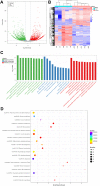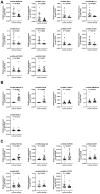circRNA-TBC1D4, circRNA-NAALAD2 and circRNA-TGFBR3: Selected Key circRNAs in Neuroblastoma and Their Associations with Clinical Features
- PMID: 34093041
- PMCID: PMC8168971
- DOI: 10.2147/CMAR.S297316
circRNA-TBC1D4, circRNA-NAALAD2 and circRNA-TGFBR3: Selected Key circRNAs in Neuroblastoma and Their Associations with Clinical Features
Abstract
Objective: The roles of circRNAs in neuroblastoma (NB) are unclear. We used next-generation sequencing to detect the circRNA expression profiles in NB to identify the key circRNAs and analyzed the relationships between the circRNAs and clinical features.
Methods: Five paired neuroblastoma tumor and adjacent normal fetal adrenal medulla samples were collected for high-throughput RNA sequencing. Bioinformatics analysis was performed for functional annotation of the host genes of differentially expressed circRNAs. Validation of dysregulated circRNAs was performed by real-time quantitative reverse transcription polymerase chain reaction. The relationships between the key circRNAs and clinical features were analyzed. In addition, overexpression of key circRNAs in an NB cell line, as well as cell proliferation assays, colony formation assays and cell migration assays, was conducted to investigate the biological functions of key circRNAs.
Results: A total of 4704 differentially expressed circRNAs were found, including 2462 up-regulated and 2242 down-regulated circRNAs. According to our previous studies, the predicted target circRNAs of miR-21 involved in tumorigenic signaling pathways were selected, including circRNA-TBC1D4, circRNA-NAALAD2 and circRNA-TGFBR3. These circRNAs were associated with clinical features, and the circRNA expression was significantly lower (P < 0.05) in the NB tissues than in normal adrenal tissues. Overexpression of circRNA-TBC1D4 promotes NB cell migration, but not proliferation and colony-formation in vitro.
Conclusion: We suggest that circRNA-TBC1D4, circRNA-NAALAD2 and circRNA-TGFBR3 may be cancer suppressor genes, which act by sponging miR-21 in NB. Further investigations are needed to elucidate the underlying mechanism.
Keywords: circRNA; circRNA-TBC1D4; miR-21; neuroblastoma.
© 2021 Lin et al.
Conflict of interest statement
The authors declare that they have no competing interests.
Figures




Similar articles
-
Recent advances and application value of circRNA in neuroblastoma.Front Oncol. 2023 Apr 6;13:1180300. doi: 10.3389/fonc.2023.1180300. eCollection 2023. Front Oncol. 2023. PMID: 37091173 Free PMC article. Review.
-
RNA sequencing reveals the expression profiles of circRNA and indicates that circDDX17 acts as a tumor suppressor in colorectal cancer.J Exp Clin Cancer Res. 2018 Dec 27;37(1):325. doi: 10.1186/s13046-018-1006-x. J Exp Clin Cancer Res. 2018. PMID: 30591054 Free PMC article.
-
Microarray Expression Profile and Functional Analysis of Circular RNAs in Osteosarcoma.Cell Physiol Biochem. 2017;43(3):969-985. doi: 10.1159/000481650. Epub 2017 Sep 29. Cell Physiol Biochem. 2017. PMID: 28957794
-
Screening and bioinformatics analysis of circular RNA expression profiles in hepatitis B-related hepatocellular carcinoma.Cancer Biomark. 2018;22(4):631-640. doi: 10.3233/CBM-170910. Cancer Biomark. 2018. PMID: 29914004
-
Circular RNAs in neuroblastoma: Pathogenesis, potential biomarker, and therapeutic target.Pathol Res Pract. 2022 Oct;238:154094. doi: 10.1016/j.prp.2022.154094. Epub 2022 Aug 28. Pathol Res Pract. 2022. PMID: 36087416 Review.
Cited by
-
Recent advances and application value of circRNA in neuroblastoma.Front Oncol. 2023 Apr 6;13:1180300. doi: 10.3389/fonc.2023.1180300. eCollection 2023. Front Oncol. 2023. PMID: 37091173 Free PMC article. Review.
-
In Vitro Assessment of the Role of p53 on Chemotherapy Treatments in Neuroblastoma Cell Lines.Pharmaceuticals (Basel). 2021 Nov 19;14(11):1184. doi: 10.3390/ph14111184. Pharmaceuticals (Basel). 2021. PMID: 34832966 Free PMC article.
-
Identification of methylation driver genes for predicting the prognosis of pancreatic cancer patients based on whole-genome DNA methylation sequencing technology.Heliyon. 2024 Apr 22;10(9):e29914. doi: 10.1016/j.heliyon.2024.e29914. eCollection 2024 May 15. Heliyon. 2024. PMID: 38737285 Free PMC article.
-
CircRNA-ACAP2 contributes to the invasion, migration, and anti-apoptosis of neuroblastoma cells through targeting the miRNA-143-3p-hexokinase 2 axis.Transl Pediatr. 2021 Dec;10(12):3237-3247. doi: 10.21037/tp-21-527. Transl Pediatr. 2021. PMID: 35070838 Free PMC article.
-
CircRNAs: functions and emerging roles in cancer and immunotherapy.BMC Med. 2025 Aug 15;23(1):477. doi: 10.1186/s12916-025-04306-5. BMC Med. 2025. PMID: 40817061 Free PMC article. Review.
References
LinkOut - more resources
Full Text Sources

